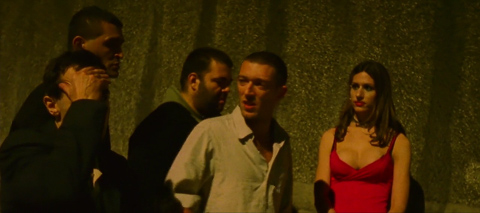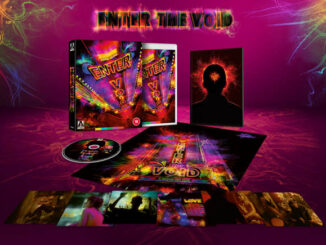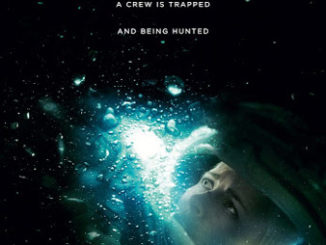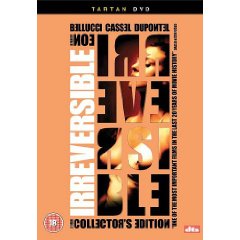Irreversible (2002)
Directed by: Gaspar Noé
Written by: Gaspar Noé
Starring: Albert Dupontel, Jo Prestia, Monica Bellucci, Vincent Cassel
FRANCE
AVAILABLE ON BLU-RAY; NOW, from INDICATOR
RUNNING TIME: 90 mins [Theatrical Cut 95 mins]
REVIEWED BY: Dr Lenera
MAJOR SPOILERS!

Alex and Marcus are a couple in Paris. Alex thinks that she’s pregnant, and both are really happy with the possibility. When Marcus goes out to bUy some wine to take round to a party, Alex takes a pregnancy test and her suspicions are happily confirmed. They go to the party with Pierre, a friend of Marcus’s who once went out with Alex. However, Alex is annoyed with Marcus’s flirtatious behaviour and unrestrained use of drink and drugs, so she leaves the party on her own and is about to be subjected to a truly horrible ordeal….

I suppose, really, it’s about the rape scene. While this may sound like a crass statement, and there is so much else in Irreversible to talk about, there’s no doubt that its almost unbearable scene of sexual assault that takes place bang in the middle is the thing that Gaspar Noe’s film will always be known for far more than anything else. As its heroine is attacked by a pimp who seems to be partly doing this for classist reasons and says “that was good, amazing” afterwards, the camera adopts a fixed viewpoint right beside the act and remains there for the duration, no cuts taking place to either dilute or enhance [depending on your attitude to such things] what we’re seeing, it just is – the horrendous violation of one human being by another. This is, perhaps, why our beloved BBFC never requested edits to the scene while many other sequences of rape had to be shortened; we’re still not legally allowed to see all of I Spit On Your Grave, though it could happen one day seeing that with each submission the BBFC let more be left in. But then, while few would consider Meir Zarchi’s film to be art [though I do personally believe that it has quality and worth], Noe’s manages to be be both art and exploitation at the same time. The title, I suppose, applies to two things. Firstly, it relates to how its awful events can never be reversed, how their effects on its main characters will always be with them. Secondly, it relates to how its fourteen scenes, each consisting of what seem like single takes, occur in reverse order. Far more than being just a gimmick, this allows Noe to both subvert the rape/revenge subgenre and question its aspects that trouble many such as the glorification of revenge, to make us think of the danger of rash decisions, and to ask us to consider how mistakes can often lead to things that are far worse.
Noe had just made I Stand Alone, and wanted to make a straight forward, realistic tale of a couple starring real-life partners. He got Bellucci and Vincent Cassel interested very easily, but some of his original ideas were put aside and later became Love as the concept changed to being a tale of a couple splitting up told backwards, then something far darker. He only had a three-page draft to show to producers, and this remained all that he had in terms of a script until shooting began, with all of the scenes only briefly mapped out and all of the dialogue to be thought up on the spot. The scenes were shot in chronological order so that it was easier for the actors. Bellucci and Jo Prestia completed six takes of the rape scene over two nights, with Noe not knowing how long they were to last, that being in the hands of the actors. Noe took cocaine to give him the energy to operate the camera in the final [or rather beginning] scenes in the Rectum nightclub, which at the time was a genuine gay S&M club called Club Banque, then, fearing that he would be labeled homophobic, went back after the main production was completed and shot a short cameo as a man masturbating – though some critics bizarrely labelled him homophobic anyway. Even though it looks like we’re watching a few very long takes, some of them were actually assembled using invisible edits disguised with digital post-processing. Noe placed an almost inaudible low-frequency background noise over the first thirty minutes which caused many walkouts in cinemas, but then even in 2018 Noe was still saying things like how he doesn’t give a damn about the reactions of viewers and that he makes films for his own personal enjoyment more than anything else. The legendary premiere at the 2002 Cannes Film Festival saw as many as two hundred people leave the auditorium, three fainting during its graphic murder scene that takes place early on, and truly extreme reactions afterwards. lt was banned in Australia and New Zealand.
Irreversible begins in its Theatrical Version with an appearance from The Butcher in I Stand Alone, telling another man that he was arrested for having sex with his own daughter, before then becoming a both dizzying and pummeling assault on the senses as two men enter the Rectum and throw their weight around while various homosexual shenanigans go on all over the place, all bathed in an intense red light as if we’re in some kind of hell while the camera goes all over the place; up and down, round and round, struggling to focus on anything in a representation of what Marcus’s mind is like right now. It’s not long before we see the other scene that sickened many, as a guy’s head is bashed in with a fire extinguisher over and over again in gloating Lucio Fulci fashion in a seamless combination of practical and CG effects. The fact that we don’t know why this is happening is the other reason why it’s so shocking, and I said to myself that it’s one scene that wouldn’t be nearly as effective in Noe’s Straight Cut of the film which is what I’m going to focus more on from here on as well as comparing the two edits; readers wishing to read a fuller review of the original version can access one from one of our early writers, Matt Wavish here, and I’ll say right now that I agree with everything he says; this film is a masterpiece, though perhaps paradoxically a masterpiece that I’ve only been able to sit through twice due to how upsetting some of it is. But is it still a masterpiece in its Straight Cut which puts all the scenes in chronological order? I must say that I initially found it baffling that Noe would wish to do such a thing, seeing as his going-back-in-time approach seemed integral to the intent of his film, a film which – for example – makes us think more seriously about its violence by placing it earlier so that we don’t get it as exploitative payoffs. But I couldn’t not buy Indicator’s magnificent release of the film and therefore give the Straight Cut a go which, while lacking some of the effect and meaning of the Theatrical Cut, does have its own qualities and is a most worthwhile alternate version.

We still begin with those BOOM BOOM credits and then a re-ordered and partly mirrored version of what was originally the last scene so that we now begin with a flashing image where can eventually make out the Milky Way as the strobe effect slows down to reveal blue sky and we spin down to where Alex is reading a book, before we move away from her and look down upon a kid’s toy helicopter and spin round and round it in strange imitation of its rotor blades if they moved. The book is J. W. Donne’s “An Experiment with Time,” which suggests that in dreams you can move backwards and forwards in time. Even though this is ominously referred to again a short while later, it actually adds a rare [for this film] positive dimension, seeing that after her ordeal we can wonder if Alex might be able to make returns to her previous life in her head. Now I’m going to briefly get personal here and mention how this scene in the Theatrical Cut was one I found so totally heartbreaking the first time around that the tears really fell. It has a beautiful young woman lying on the grass, totally relaxed and happy about the fact that she could have new life growing inside her, even though she hasn’t told her boyfriend yet. She seems so at ease, almost at one with nature. And yet this happiness is soon going to be taken from her in the most horrible way. We’re asked to consider a life that will be ruined, how fragile happiness can be, how any one of us can have our lives suddenly changed in a terrible way. For me, it remains one of the most devastating conclusions to a film despite the lush colours which add their own bitter, ironic aspect. Now, in this Straight Cut, this feeling is no longer there, as well as the bit where Alex sits holding her belly under a poster of 2001: A Space Odyssey because it wouldn’t work well in the context of this new version.
However, we’re now able to focus more on the events that lead up to the rape. Because of how shocking that scene is, it dominates our thoughts for the rest of the film and we do more picking up of intentional or unintentional foreshadowing than become truly immersed in the actual sequences they’re in. While the scenes that are next in this version of Alex and Marcus at home have always had a lovely sexiness to them, partly because of course we know that we’re watching a real-life couple and their ease with each other is totally transmitted to the viewer, before we couldn’t help but contrast them with the brutality of the rape that will happen that night. We have that awful imagery in our minds, and can’t quite compute the beauty of what we’re seeing. We’re even in the strange position of almost preferring it that they don’t know what’s just around the corner so they can enjoy these moments. But now this isn’t the case, and we actually wish these bits would go on for longer. Of course we then get to Alex and Marcus meeting up with Pierre and going to this party together. Pierre is initially highly annoying the way that he keeps on going on about him having been unable to give Alex orgasms when they were together, but it soon becomes apparent that he’s still in love with Alex and doesn’t like it that Marcus is such a jerk, openly kissing other women right in front of Alex and more interested in getting wasted than anything else. Marcus seems even more dislikeable here than before because in his introductory scene he seemed fine. We haven’t seen him racially insult a Chinese taxi driver then take his vehicle, attack a few men, and hold a knife to a prostitute’s throat and threaten to cut her face up if she doesn’t give him the information he wants. But on the other hand we don’t get as much a sense of the terrible mistake that he makes him in letting her go home on her own, especially considering how she’s dressed. Previously, we saw the rape, then the party which made us really angry when he let her go; here, we don’t feel such anger.
It’s really swings and roundabouts. When Marcus goes berserk, we now know that he’s had a lot of cocaine which makes his behaviour a bit more understandable. Noe has said that one of his reasons for doing this cut was that we could better appreciate the performances of his actors, and this is certainly achieved, especially with Cassell, in these scenes. Some of the sexual footage inside Rectum has been removed for some reason, but I was wrong about that fire extinguisher assault; it’s just as shocking here. This is because, while we do now know why it’s being committed, Pierre, who up to now has been the voice of reason and tried to hold Marcus back, is attacking the wrong man who has the right man standing right next to him! Therefore we still get the idea of how revenge can go horribly wrong. Some of the transitions involving wild camerawork have been shortened, though Noe says that this was done because they wouldn’t have worked very well in a linear film and he was probably right. Noe has certainly put together this version with thought and care even if he probably began working on it as just a fun experiment. There’s no doubt that some of his film’s power is lost, from the idea of lives about to be shattered down to bitter ironies like us seeing somebody punished for a crime we have not yet seen him commit. Its structure makes for a more conventional film, with its slow pacing until the rape, after which it then moves like a bullet that also seems to exploit its violence more. Yet this version enhances some other qualities and even creates some new ones. Even if you’re still of the totally understandable opinion that this is a pointless travesty or even an insult, I’d still recommend that you watch it if you love Irreversible -well, love probably isn’t the right word. I don’t love it at all, but I admire it tremendously, and that admiration was not undone by this unique alternate and surprisingly valid version. It’s not the version I can see myself returning to in the future; but as I said earlier I don’t watch it often anyway.
Rating: 














Be the first to comment